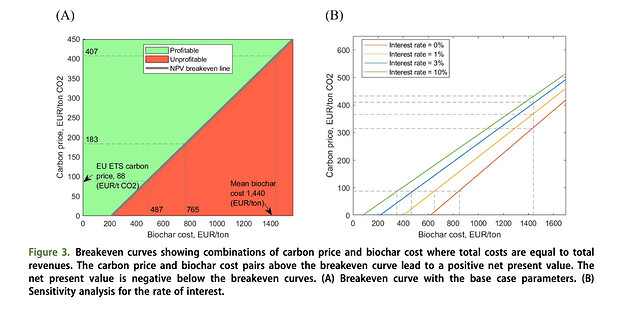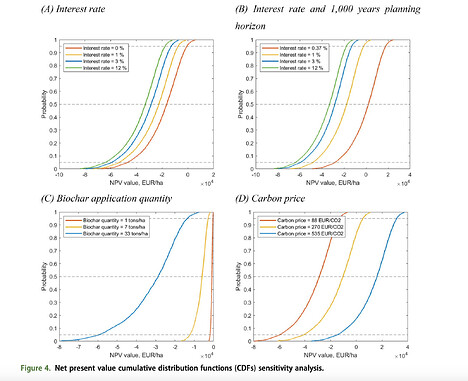This week, we take a deep dive into a paper recently published in Carbon Management. The study was conducted by a team of researchers based in Finland, led by Medile Jokube from the Department of Economics and Management of the University of Helsinki, in Helsinki (Finland).
The paper investigates the economic feasibility of using biochar, a form of charcoal produced from organic material through pyrolysis, as a method to enhance carbon capture and storage capacity in Finland. Via numeric simulations, the authors assess the economic feasibility of increasing Finnish mineral agricultural soil carbon stock using biochar, in a scenario where the climate is increasingly dry and warm. Results show that, given current carbon prices and biochar costs, it is hard to attain economic feasibility for this carbon dioxide removal (CDR) technology.
The study highlights biochar’s potential for long-term carbon sequestration in soils, which can contribute to Finland’s climate goals: as biochar can stabilize carbon in soil for decades to centuries, it has a high potential to offset emissions from agriculture. Through a cost-benefit analysis, the authors argue that while initial costs can be high, long-term benefits may offer economic returns over time. These include increased soil fertility and potential yield improvements – through enhanced nutrient retention and increased microbial activity – which could be especially beneficial given the characteristics of Finnish soils, which are often acidic and nutrient-poor. The economic feasibility of biochar is also influenced by regional factors, including the availability of biomass for biochar production and the scale of application. More crucially, the authors discuss how different policy interventions, such as carbon credits or subsidies for biochar production and application, would be key to making biochar more economically competitive.
In particular, the authors assess what conditions would make biochar application economically feasible under different policy scenarios separately and under a joint mixed scenario. In the presence of a carbon subsidy at the current European Union Emissions Trading System (EU ETS) level, with a carbon price of 88 EUR/t CO2eq, results show that biochar material prices should massively decrease to less than one-third of current average levels to ensure feasibility. Alternatively, the same goal could be achieved through a large subsidy, between two to nine times larger than the EU ETS carbon price, paid to farmers for biochar production, given current biochar market prices. Lastly, should both policies be implemented, the objective could be reached through a simultaneous doubling of the carbon price and halving of the average biochar cost. Results show that the Net Present Value (NPV), accounting for costs and benefits that farmers would face in the event they apply biochar to a field under a given policy, is most sensitive to the levels of interest rate, planning horizon length, biochar application quantity, and carbon price.
Here is a list of the main takeaways from this paper:
- Enhancing carbon stocks with biochar in Finnish agricultural soils is economically challenging under current carbon prices and biochar production costs.
- Producing biochar from straw in Finland involves significant capital and operational expenses, necessitating high market prices per ton to ensure profitability.
- Results from simulations indicate that achieving economic feasibility requires favorable conditions, which are difficult to meet with existing market dynamics.
- Biochar projects have potential in carbon markets, but current trading volumes are limited, and prices may not yet support widespread adoption.
- The increasing frequency of dry and warm climate scenarios in Finland may affect biochar’s effectiveness and the feasibility of carbon sequestration projects.
Read the full paper here: Economic feasibility of biochar for carbon stock enhancement in Finnish agricultural soils

